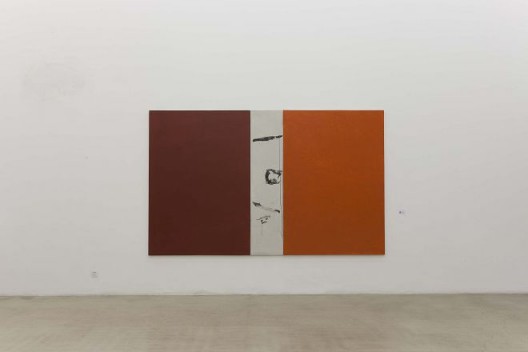“The Third Abstraction” & “Zhu Qingsheng”
Chambers Fine Art (Red No.1-D, Caochangdi, Chaoyang District, Beijing), Nov 7–Dec 27, 2015
Professor Zhu Qingsheng, of the history department at Peking University, has divided the development of abstract art into three stages: “The First Abstraction” represented by Kandinsky and Mondrian, emphasized the spiritual meaning behind form; “The Second Abstraction”, consisting of Cubism, Abstract Expressionism and Minimalism, emphasized forms and states left by action and strength. Compared to these two stages, “The Third Abstraction” returns to the essence of human nature, that chemical reaction as the body comes into contact with matter, and the spiritual nurturing from within. Yet the thrust of focus in his research exhibition “The Third Abstraction” does not address abstract art per se, but rather the way to interpret the core values of “spirit resonance” and “brushstrokes” in traditional aesthetics of Chinese art by adopting an international artistic idiom. Since the Wei–Jin and Northern and Southern dynasties to the present day, it seems difficult to imagine what kind of vitality are left in these two components of the six principles today. Abstraction—which simplifies visual content—often steers the viewer’s senses towards ideas of the interior and of the profound through visual symbolism and colors. And yet its core value is often perceived by many intellectuals with a superficial understanding; for viewers outside of the field, the artwork seem to have little effect other than sensual pleasure. As an academic exhibition, the interpretation of the value of traditional aesthetics of Chinese art with abstract artists would be much like discussing an esoteric subject among a small crowd.
Shang Yang’s symbolic icons are coincidental outcomes through repetitive editing and smudging in the course of painting, while Yan Shanchun infuses his sentiments of West Lake scenery into his fluid brushwork, burying his emotional memories through the layers. One sees how Tan Ping addresses the relationship between mind-body and matter, while Wang Huaiqing focuses on the timely qualities embedded in particular objects. Additional, original calligraphy by Dong Qichang (with Deng Tuochang’s colophon) is also on view. Juxtaposing paintings with calligraphy, the viewer was informed of the relationship between Chinese tradition and abstract art.
Moreover, Zhu Qingsheng, as one of the participating artists, has put theory into practice. In the exhibition of the same title, his work Calligraphy Writ Large presents a brushstroke magnified 100 times. A sole brushstroke separated from any Chinese character becomes an abstract icon, its adamant dimensions emphasizing the calligrapher’s spiritual state as he moves the brush.

谭平,《一剪梅》,布面丙烯,200×300cm,2005

严善錞,《西湖梦寻》系列,布面亚克力,综合材料,212×152cm,2009

朱青生,《放大书法07909》,布面朱墨,240×840cm,2015

朱青生 & 第三抽象,展览现场

朱青生 & 第三抽象,展览现场

朱青生 & 第三抽象,展览现场

朱青生 & 第三抽象,展览现场